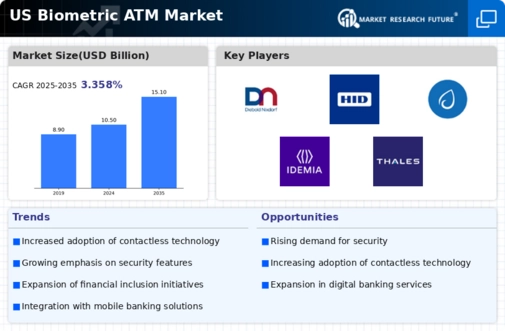Rising Concerns Over Fraud and Security
In the context of the biometric atm market, rising concerns over fraud and security are significant drivers. Financial institutions are increasingly targeted by cybercriminals, leading to substantial financial losses. In 2024, it was reported that losses due to ATM fraud in the US reached approximately $1.5 billion. This alarming trend has prompted banks to invest in more secure solutions, such as biometric ATMs, which offer enhanced protection against unauthorized access. By utilizing biometric authentication methods, banks can significantly reduce the risk of fraud, thereby safeguarding their assets and maintaining customer trust. The urgency to address these security challenges is likely to propel the growth of the biometric atm market, as institutions prioritize the implementation of advanced security measures to protect their customers and their financial data.
Regulatory Support for Biometric Solutions
Regulatory support for biometric solutions is emerging as a crucial driver in the biometric atm market. Government agencies are increasingly recognizing the importance of secure banking practices and are encouraging the adoption of biometric technologies. In 2025, new regulations were introduced that incentivize financial institutions to implement advanced security measures, including biometric authentication. These regulations aim to enhance consumer protection and reduce fraud in the banking sector. As banks comply with these regulations, the demand for biometric ATMs is likely to increase, as they provide a robust solution to meet regulatory requirements. This supportive regulatory environment is expected to foster innovation and investment in the biometric atm market, ultimately leading to a more secure and efficient banking landscape.
Technological Advancements in Biometric Systems
The biometric atm market is experiencing a surge due to rapid technological advancements in biometric systems. Innovations such as fingerprint recognition, facial recognition, and iris scanning are becoming increasingly sophisticated, enhancing the security and efficiency of ATMs. According to recent data, the biometric authentication market is projected to grow at a CAGR of approximately 20% through 2027. This growth is likely to drive the adoption of biometric ATMs, as financial institutions seek to leverage cutting-edge technology to improve customer experience and reduce fraud. The integration of artificial intelligence and machine learning into biometric systems further enhances their reliability, making them more appealing to banks and consumers alike. As these technologies evolve, they are expected to play a pivotal role in shaping the future of the biometric atm market, potentially leading to widespread implementation across various financial institutions.
Consumer Demand for Convenient Banking Solutions
The biometric atm market is also driven by consumer demand for convenient banking solutions. As customers increasingly seek seamless and efficient banking experiences, the adoption of biometric ATMs is likely to rise. These ATMs offer quick and easy access to funds without the need for traditional PINs or cards, which can be cumbersome. A survey conducted in 2025 indicated that over 60% of consumers prefer biometric authentication methods for their convenience and speed. This shift in consumer preference is pushing banks to adopt biometric technologies to enhance customer satisfaction and loyalty. As financial institutions respond to this demand, the biometric atm market is expected to expand, with more banks integrating biometric solutions into their ATM networks to meet evolving consumer expectations.
Competitive Pressure Among Financial Institutions
Competitive pressure among financial institutions is a notable driver of the biometric atm market. As banks strive to differentiate themselves in a crowded marketplace, the adoption of innovative technologies such as biometric ATMs becomes a strategic imperative. Institutions that offer advanced security features and enhanced customer experiences are likely to attract more customers. In 2025, it was reported that banks implementing biometric solutions saw a 15% increase in customer retention rates. This competitive dynamic is pushing financial institutions to invest in biometric technologies to stay ahead of rivals. As the market becomes increasingly competitive, the biometric atm market is expected to grow, with more banks adopting biometric solutions to enhance their service offerings and maintain a competitive edge.
















Leave a Comment